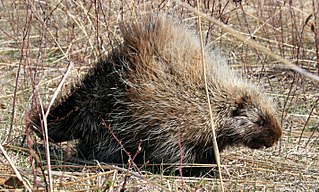
Porcupines are large rodents with coats of sharp spines, or quills, that protect them against predation. The term covers two families of animals: the Old World porcupines of the family Hystricidae, and the New World porcupines of the family Erethizontidae. Both families belong to the infraorder Hystricognathi within the profoundly diverse order Rodentia and display superficially similar coats of rigid or semi-rigid quills, which are modified hairs composed of keratin. Despite this, the two groups are distinct from one another and are not closely related to each other within the Hystricognathi. The largest species of porcupine is the third-largest living rodent in the world, after the capybara and beaver.

The Old World porcupines, or Hystricidae, are large terrestrial rodents, distinguished by the spiny covering from which they take their name. They range over the south of Europe and the Levant, most of Africa, India, and Southeast Asia as far east as Flores. Although both the Old World and New World porcupine families belong to the infraorder Hystricognathi of the vast order Rodentia, they are quite different and are not particularly closely related.

The sun bear is a species in the family Ursidae occurring in the tropical forests of Southeast Asia. It is the smallest bear species, standing nearly 70 cm (28 in) at the shoulder and weighing 25–65 kg (55–143 lb). It is stockily built, with large paws, strongly curved claws, small, rounded ears and a short snout. The fur is generally short and jet black, but can vary from grey to red. The sun bear gets its name from its characteristic orange to cream-coloured chest patch. Its unique morphology—inward-turned front feet, flattened chest, powerful forelimbs with large claws—suggests adaptations for climbing.

The Cape porcupine, Cape crested porcupine or South African porcupine, is a species of Old World porcupine native to central and southern Africa.

The Indian crested porcupine is a hystricomorph rodent species native to southern Asia and the Middle East. It is listed as Least Concern on the IUCN Red List. It belongs to the Old World porcupine family, Hystricidae.

Hystrix is a genus of porcupines containing most of the Old World porcupines. Fossils belonging to the genus date back to the late Miocene of Africa.

The crested porcupine, also known as the African crested porcupine, is a species of rodent in the family Hystricidae native to Italy, North Africa and sub-Saharan Africa.
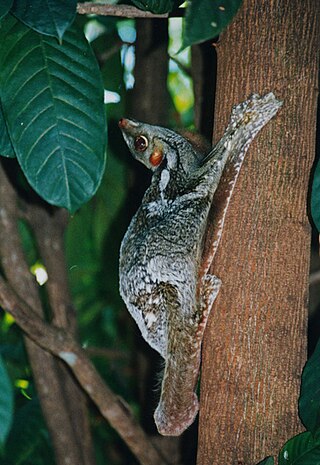
The Sunda flying lemur, Sunda colugo, Malayan flying lemur or Malayan colugo is the sole colugo species of the genus Galeopterus native to Southeast Asia ranging from southern Myanmar, Thailand, southern Vietnam, Malaysia to Singapore and Indonesia.
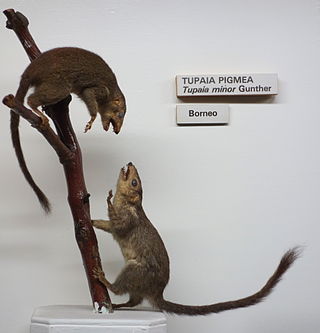
The pygmy treeshrew is a treeshrew species within the family Tupaiidae. It is native to Thailand, Malaysia and Indonesia. The generic name is derived from the Malay word tupai meaning squirrel or small animals that resemble squirrels.

The Asiatic brush-tailed porcupine is a species of rodent in the family Hystricidae. It is found in China, Bhutan, India, Laos, Malaysia, Myanmar, Thailand, and Vietnam.

Prevost's squirrel or Asian tri-colored squirrel is a colourful species of rodent in the family Sciuridae. It is found in forests in the Thai-Malay Peninsula, Sumatra, Borneo and nearby smaller islands, with an introduced population in northern Sulawesi. Although the Prevost's squirrel is declining in some regions because of habitat loss and hunting, the species is not considered threatened since it generally remains common and widespread. It can live in somewhat disturbed habitats and often visits plantations or gardens. It mostly feeds on plant material, especially fruits, but also takes insects.

The thick-spined porcupine is a species of rodent in the family Hystricidae. It is endemic to the island of Borneo and found in Brunei, Indonesia, and Malaysia.

The Sunda porcupine also known as Javan porcupine is a species of rodent in the family Hystricidae. It is endemic to Indonesia. Due to the popularity of the hunting and consumption of the Sunda porcupine as an aphrodisiac, the Ministry of Environment and Forestry in Indonesia has listed this species as a protected animal as of June 2018.
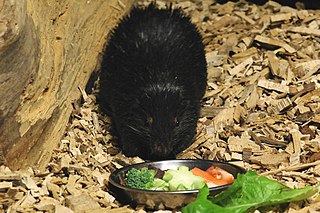
The Philippine porcupine or Palawan porcupine is a species of rodent in the family Hystricidae endemic to the island of Palawan in the Philippines. It is known locally as durian or landak.
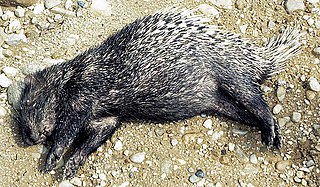
The Sumatran porcupine is a species of rodent in the family Hystricidae. It is endemic to the Indonesian island of Sumatra, where it is hunted for food.

The long-tailed porcupine is a species of rodent in the family Hystricidae. It is monotypic within the genus Trichys, and is found in Brunei, Indonesia, and Malaysia.

The Malayan weasel or Malay weasel is a weasel species native to the Malay Peninsula and the islands of Sumatra and Borneo. It is listed as Least Concern on the IUCN Red List.

Acanthion is a subgenus of Old World porcupines in the genus Hystrix. It contains two species, H. javanica and H. brachyura, the smaller species with comparatively smaller nasals. The extant species have only one black ring or coloured part on the quills.

Hystrix refossa is an extinct species of large porcupine that was widespread in Eurasia during the Pleistocene.























